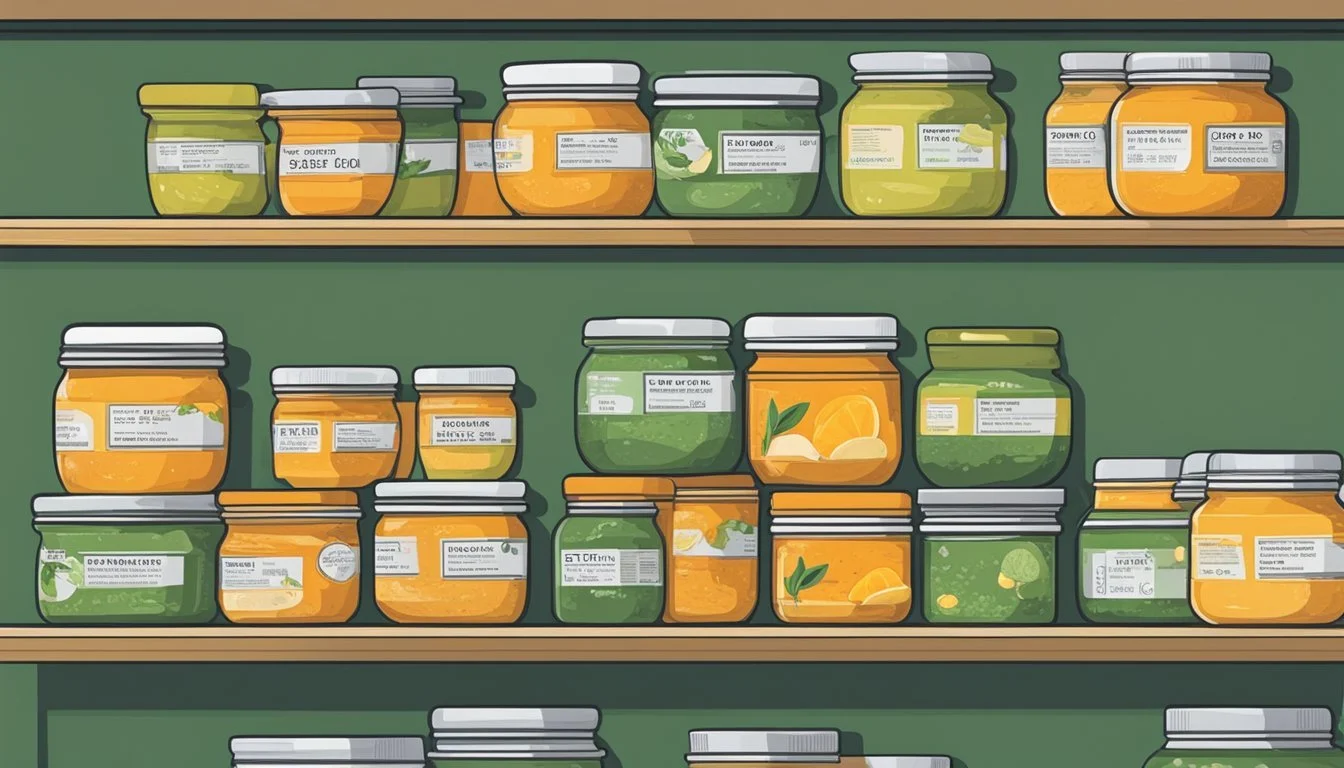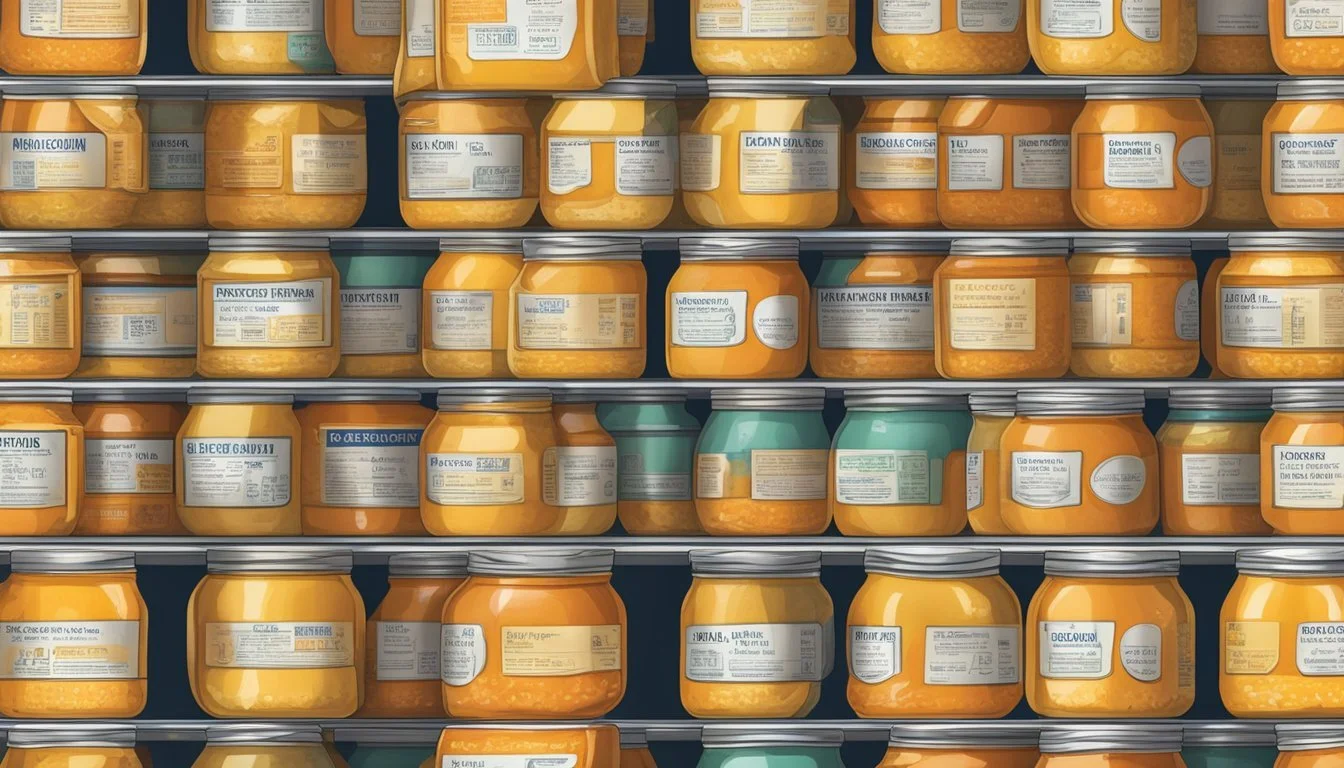How Long Does Canned Tangerine Curd Last?
Shelf Life and Storage Tips
The shelf life of home-canned products is an important consideration for those looking to maintain the quality and safety of their preserved foods. Tangerine curd, with its delightful balance of sweet and tangy flavors, is no exception. Typically, the shelf life of home-canned goods like tangerine curd is shorter compared to other canned foods due to its higher acidity and dairy content.
To ensure the best quality, it’s advised to use home-canned tangerine curd within 3 to 4 months. During that period, the curd should retain its vibrant color and fresh taste that is characteristic of well-preserved citrus products. Although it may remain safe to eat beyond this timeframe, changes in its texture and flavor could occur, diminishing its palatability. Consumers should discard any jars of tangerine curd showing signs of browning or separation, as these changes can indicate spoilage.
Safe canning practices are essential when preserving foods at home. This involves not only adhering to the recommended usage timeframe but also following proper canning techniques and storage conditions. A cool, dark, and dry environment helps to prolong the shelf life and maintain the integrity of the curd. Therefore, individuals preparing tangerine curd, or any home-canned good, should stay informed on the latest canning guidelines and inspect their canned items regularly to ensure safety and quality.
Understanding Tangerine Curd
Tangerine curd is a versatile spread that marries the vibrant flavor of tangerines with a creamy texture, making it a favorite in various recipes. This section will explore what defines tangerine curd and how it compares to other citrus-based curds.
Definition and Basic Ingredients
Tangerine curd is a dessert spread made primarily from tangerine juice and zest, sugar, butter, and eggs. The ingredients are cooked together until thickened, resulting in a smooth, richly flavored cream with a balance between sweetness and the characteristic tang of citrus. The essential ingredients of tangerine curd are:
Tangerine juice and zest: A key source of the distinct tangerine flavor
Sugar: Adds sweetness and contributes to the curd's preservation
Butter: Provides a smooth and creamy texture
Eggs: Act as thickening agents and emulsifiers, binding the curd
These components combine to create a curd that is deeply aromatic with a bright, citrusy essence that makes it suitable for various uses, from fillings to toppings.
Comparison with Other Citrus Curds
Citrus curds share a common base of ingredients, including citrus juice, sugar, butter, and eggs. However, different types of fruit curds, such as lemon, lime, and tangerine, vary primarily in their source of fruit juice and zest. Here's a comparison highlighting the characteristics of tangerine curd relative to its citrus counterparts:
Curd Type Citrus Base Flavor Profile Color Lemon Curd Lemon juice and zest Zesty and quite tart Pale yellow Lime Curd Lime juice and zest Sharp and tangy Green-tinged yellow Tangerine Curd Tangerine juice and zest Sweet with a more muted tartness than lemon Orange Orange Curd Orange juice and zest Sweet with a subtle tartness Orange-yellow
Tangerine curd distinguishes itself with its fruit-driven sweetness and milder tartness, contrasted by the bold tart flavor of lemon curd. It stands out in recipes that require a gentler citrus note, all while retaining a smooth and spreadable texture that is characteristic of all citrus curds.
Canning and Preserving Tangerine Curd
The proper canning and storage of tangerine curd is crucial for ensuring both the safety and quality of this home-preserved delicacy. The shelf life, taste, and integrity of the curd depend largely on following precise canning methods and storage guidelines.
Canning Process
To begin, one should prepare the tangerine curd recipe using fresh tangerines, sugar, eggs, and butter. Once the curd is cooked, the canning process starts by filling sterilized half-pint jars with the curd, leaving an adequate headspace of approximately 1/2 inch. It is paramount to eliminate any air bubbles by gently stirring the mixture within the jars. Jars are then sealed with lids to fingertip tightness, ensuring an environment conducive to creating a proper vacuum seal later in the process.
The filled jars are placed into a water bath canner, where the water should already be heated to 180 degrees Fahrenheit. The temperature is slowly increased to boil, meticulously monitored to avoid any sudden temperature changes that might compromise the integrity of the jars or curd. The complete boiling process should be sustained for about 15 minutes to ensure proper sealing.
Sealing and Storage
After boiling, the jars are removed from the canner to cool and seal. The listener will hear a distinctive "pop" sound indicating a successful seal. Once cooled, they must check the lids for a slight indentation that denotes an airtight seal, which protects the curd from spoilage and contamination.
For storage, they place the sealed jars in a cool, dark place. Home-canned tangerine curd should be consumed within 3 to 4 months for the best quality and safety. After opening, it's critical to refrigerate the curd, where it remains good for up to two weeks. Freezing is not advised as it can alter the texture and consistency of the curd. Always check for any signs of spoilage before consuming and discard any jars where the seal has been compromised or an off odor, appearance, or taste is detected.
Assessing Quality and Shelf Life
It is essential for consumers to understand how to determine the quality and estimated shelf life of canned tangerine curd to ensure both safety and enjoyment. The two critical factors to monitor are signs of spoilage and adherence to expiration or use-by dates.
Identifying Spoilage
One can assess the quality of canned tangerine curd by looking for:
Color changes: A fresh tangerine curd typically has a bright, vibrant color. Any dullness or browning may indicate spoilage.
Texture alterations: Separation, or a change in consistency, can be a sign that the curd is no longer fresh.
Odors: An off-smell is often the first indicator that a canned good should not be consumed.
Can integrity: Bulging, rusting, or leaking shows that the contents may be compromised and can pose a health risk.
Expiration and Use-By Dates
While canned foods can last longer than many fresh counterparts, they still have recommended consumption windows:
Use-By Dates: It's advised to use the curd before this date for the best quality and taste, though it can remain safe to consume after this period if stored correctly.
Shelf Life: Typically, home-canned tangerine curd should be used within 3-4 months when stored in a cool, dark place. After this period, quality may degrade, even if safety isn't immediately compromised.
Storage: For longevity, the curd should be kept away from light at a consistent temperature, ideally below 70°F (21°C).
Consumers should always rely on both the visual and olfactory examination in conjunction with dates provided to determine the suitability of canned tangerine curd for consumption.
Nutritional Information
Canned tangerine curd, as with most fruit curds, is a sweet spread typically comprising a substantial amount of sugar and citrus fruit, which offers a burst of flavor along with nutritional benefits. This section breaks down the macro-nutrient and micro-nutrient content found in canned tangerine curd, focusing on the key dietary components.
Macro-nutrient Breakdown
Calories: The caloric content of canned tangerine curd is relatively high due to its sugar and fat components. The exact number of calories can vary depending on the recipe and added ingredients.
Fat: Usually, there is a modest amount of fat in tangerine curd from the butter used to create a smooth consistency. This includes some saturated fat.
Protein: Protein levels in fruit curds are typically low.
Carbohydrates: Canned tangerine curd is high in carbohydrates, primarily from sugars, which provide the sweet taste characteristic of fruit curds.
Fiber: The amount of fiber is generally minimal, as the fruit's pulp and zest are not commonly used in curds.
Sugar: It is a key ingredient for both taste and preservation, representing a significant portion of the carbohydrates.
Micro-nutrient Content
Vitamin C: Tangerines are naturally high in vitamin C, but the content may be reduced during the cooking and canning process.
Iron: Iron content in canned tangerine curd is generally low.
Sodium: Sodium levels can vary; if added for flavor balance, it might increase the sodium content slightly but is usually not a significant amount in fruit curds.
Using Tangerine Curd
Tangerine curd is prized for its vibrant citrus flavor and smooth texture. It incorporates fresh tangerine juice and zest, offering a burst of color and taste to various dishes.
Culinary Applications
Tangerine curd’s thick consistency and tangy sweetness make it a versatile component in the kitchen. It is typically used as:
Spread: On toast or scones for a fresh, tangy start to the day.
Filling: For cakes, such as a sponge or layer cakes, and tarts, providing a citrusy contrast.
Topping: Dolloped onto yogurt, ice cream, or puddings, enhancing them with its bold, sweet flavor.
Ingredient: In desserts like parfaits or trifle layers, contributing a hint of citrus zing.
Recipe Ideas and Pairings
When using tangerine curd in recipes, one can create delightful pairings that enhance its flavor profile:
Cakes: Infuse a vanilla sponge cake with tangerine curd between the layers.
Tarts: Fill a pre-baked tart shell with tangerine curd and top with fresh grapefruit segments.
Recipe Cards: Displaying simple ingredients and instructions, a recipe card for tangerine curd can guide home cooks in its use.
Citrus Variations: Combine with other citrus fruits, such as navel oranges or lemon, for a more complex flavor profile.
Recipes often call for incorporating the zest of oranges to maximize the citrus note. Navel oranges, being naturally sweeter, complement the tartness of the tangerine. A simple ingredient list ensures that the tangerine curd retains its characteristic flavor and texture, becoming a delightful addition to one's culinary repertoire.
Safety Considerations
Ensuring the safety of home-canned tangerine curd involves adhering to proper canning techniques and understanding the risks of foodborne illness. These factors are crucial for maintaining the quality and safety of the product throughout its shelf life.
Proper Canning Techniques
The key to safe home canning is following the correct procedures for creating a vacuum seal. This process involves heating the tangerine curd to eliminate harmful microorganisms and then sealing it in sterilized jars to prevent recontamination. For low-acid foods, such as tangerine curd, a pressure canner is often required to achieve the high temperatures necessary for safety.
Seal Integrity: A proper seal prevents air from entering and compromising the quality and safety of the canned product.
Storage: After canning, the sealed jars should be stored in a cool, dark place to preserve their quality. Exposure to light or heat can degrade the product more quickly.
Preventing Foodborne Illness
The primary concern in home canning is preventing the growth of Clostridium botulinum, the bacteria that cause botulism. This is especially important for low-acid foods, which create a favorable environment for the bacteria.
Visual Inspection: Before use, inspect the jars for signs of spoilage such as leaking, bulging lids, or any unusual odors. Do not consume the content if these signs are present.
Refrigeration: Once opened, tangerine curd should be stored in the refrigerator to slow down the growth of any bacteria that may have been introduced upon opening.
Expiration Date: While home-canned goods often lack a commercial expiration date, it is advisable to consume them within a year for optimal quality. After this period, the safety may not be compromised, but the quality could diminish.
Additional Tips for Longevity
Ensuring the longevity of canned tangerine curd involves meticulous storage and handling, alongside strategies to retain its freshness and flavor.
Best Practices for Storing and Handling
Storing canned tangerine curd correctly is vital to extend its shelf life while maintaining quality. An airtight container is essential after opening to prevent oxidation, which can spoil the curd. The curd should be kept in a refrigerator, ideally at temperatures between 35°F to 40°F (1.7°C to 4.4°C) for optimal preservation. It's recommended to:
Store unopened cans in a cool, dark place free from drastic temperature changes.
Once opened, transfer the remaining curd to an airtight container if it's not finished.
Maximizing Freshness and Flavor
Freshness and flavor are paramount for enjoying canned tangerine curd at its best. To maximize these elements:
Consume opened tangerine curd within 3-4 weeks to enjoy its peak taste.
Avoid exposure to light and heat as these can accelerate degradation and loss of flavor.
FAQs on Tangerine Curd Preservation
How should one store tangerine curd to ensure its longevity?
For optimal preservation, tangerine curd should be stored in the refrigerator. The cold environment slows down spoilage and maintains quality.
What is the typical shelf life of canned tangerine curd in a refrigerator?
Generally, canned tangerine curd can last in the refrigerator for up to 3-4 weeks after opening. If unopened and stored properly, it may last well beyond that, but it's best to consume within a year for premium taste and safety.
Can tangerine curd be frozen to extend its shelf life?
Yes, freezing tangerine curd is possible. To freeze, one should:
Transfer to an airtight container.
Leave some space at the top as it will expand when frozen.
Label with the date for reference.
Once frozen, it can last approximately 6 months.
What signs indicate that tangerine curd has gone bad?
Signs of spoilage include:
Off odor
Discoloration
Mold growth
If any of these signs are present, the curd should be discarded.
How does one know the expiration date of canned tangerine curd?
The expiration date is typically stamped on the can or jar by the manufacturer. However, once opened, tangerine curd should be used within the recommended timeframe even if the printed date is later.
Does freezing tangerine curd alter its texture or taste?
Freezing may slightly change the texture, leading to a less smooth consistency. The taste should remain unaffected if the curd is used within the suggested 6-month period.









